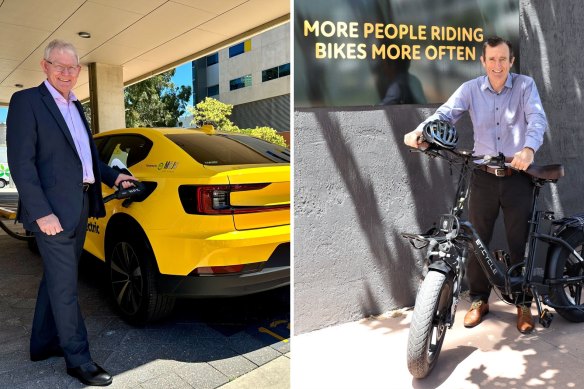
While Perth is now the longest city in the world at 150 kilometres, most of our daily trips are quite short. Every day around 4.2 million private car trips are made in Perth, and two thirds of these trips are less than five kilometres. This presents an opportunity.
A three-kilometre bike ride takes only about 12 minutes. This means there are potentially millions of trips each day we could be doing by bike, walking or on an e-rideable. This could be to the shops, to work, or to connect with public transport.

Patrick Walker is RAC Group’s social and community impact executive. Wayne Bradshaw is chief executive of WestCycle.
Currently, Perth has one of the lowest rates of active transport – walking and cycling - in the country. Half of all kids travel to school by car, despite living less than one kilometre away.
The key to turning this around is providing safe and pleasant streets, paths, and facilities for everyone – of all ages and abilities – to walk and ride as part of their daily travel.
Right now, most of our streets are designed to prioritise people using cars, and we want everyone to have more choices for how they get around. We also know that 62% of people who ride a bike at least once per month would ride more often if they had safer places to do so.
Loading
The development of the Principal Shared Path (walking and cycling) network is a great start, and it is particularly good for riding long distances. But we need to focus on local government networks, to support walking and riding in that last kilometre we use every day.
Perth also needs continued investment in public transport to build on the work already under way and completed. We need to go beyond outer suburb connections and look to improve transport options in the inner areas. This includes considering the potential benefits of diverse transport options, such as light rail and trackless trams.
Across Australia, people overwhelmingly want more investment in public transport. With congestion expected to cost Perth $3.1 billion per year by 2031, urgency is growing. Fuel prices are impacting the hip pockets, and our environment can only benefit from the shift to electric vehicles, more cycling, walking and public transport.
Infrastructure and policies that get more people considering cleaner transport options, and where possible choosing the bus, train, bike or their own two feet, will mean happier communities, faster commutes, and healthier air for current and future generations.
Loading
The 2021 National Walking and Cycling Survey found more than 20 per cent of West Australians had ridden a bike in the previous week. If that was you, well done. Let’s build on that. Can you add one extra bike trip this week?
Got a bike languishing in the back shed? Dust it off and book in a service with your local bike shop. Secondhand bikes are a low cost way to get started: any bike with a helmet, lock and lights is all you need to pick up the milk or get to school.
We all deserve safe, affordable, sustainable and pleasant ways to get from A to B. Contact your local MP to let them know you want this. When you see a request for community feedback on a new road project, have your say and let the government know.
It is a long way from Perth to COP27 in Egypt, but our actions here matter locally, nationally, and globally.
Follow WAtoday on Instagram, LinkedIn, Facebook and Twitter for handpicked selections of the day’s biggest local, national and international news.









 Add Category
Add Category